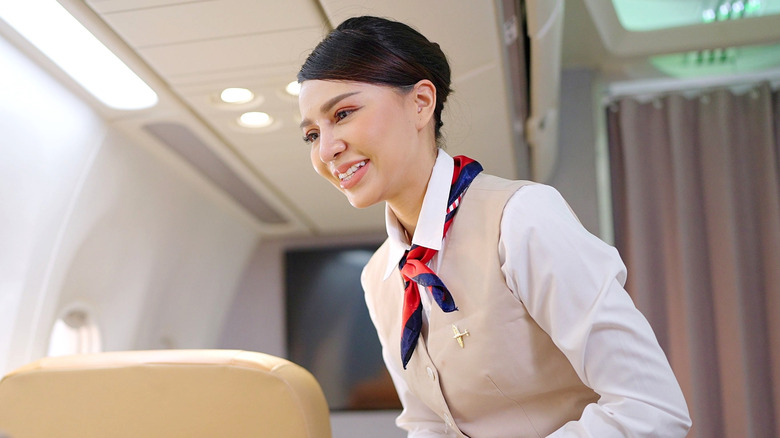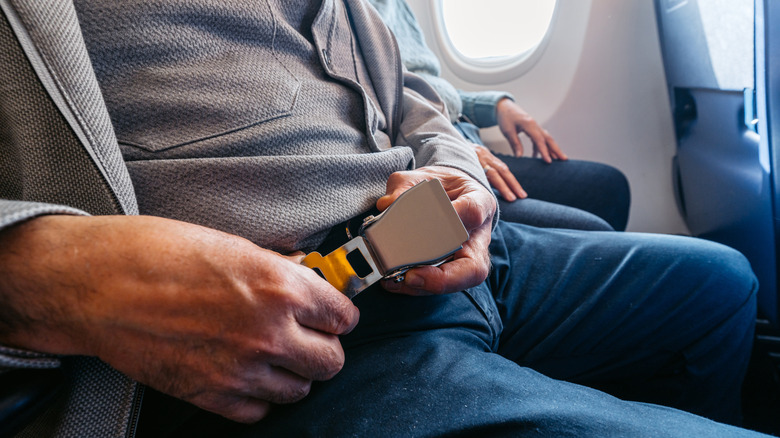Flight Attendants Always Pay Attention To Who Follows This Simple Airplane Rule
Something you learn the more you fly is that flight attendants are the true custodians of the sky. Not only do they have a responsibility to protect everyone on the plane, but they're also responsible for your comfort and that general sense of calm when you're in the air. For this and many other reasons, they are probably the most observant people on your flight. Very little said or done gets past them, and they're often paying attention to specific behaviors, including which passengers follow certain rules. One of these, which may surprise you, is whether or not you obey the seatbelt light.
As shared by some flight attendants giving tips on good behavior, being polite may be the secret to getting great service on your flight, but demonstrating certain travel habits can also show whether you're a seasoned flyer or someone they need to be aware of. Buckling up when the seatbelt light is on demonstrates an awareness of in-flight safety and respect for the people around you. It's often the people who haven't flown a lot or experienced turbulence much who feel justified unbuckling or standing up while the light is on. While these travelers may consider the seatbelt sign a suggestion and see following it as excessive obedience, they're completely missing the point.
A veteran flight attendant shared on CNN how she was "surprised to see so many unbuckled belts" despite recent incidents of severe turbulence causing injuries. Turbulence shouldn't be underestimated and can be disastrous. A recent Singapore Airlines flight demonstrated this when it dropped almost 6,000 feet in three minutes due to turbulence. Passengers not wearing seatbelts were tossed about the plane, hitting other seats, passengers, and the ceiling. Tragically, one passenger died. While not all turbulence can be predicted, such as clear-air turbulence, pilots and flight attendants often know when it's coming up thanks to warnings from other aircraft. That's why it's so important to follow their lead.
The risks of disobeying the seatbelt sign
Aside from the safety risks you impose upon yourself, other passengers, and the flight crew, there are serious legal consequences that can come to those who disobey the seatbelt sign. In the United States, ignoring the sign violates federal law but is a civil offense, not a criminal one. So while you probably won't be imprisoned for it, you could face a fine of up to $10,000. That's a very expensive flight.
This law isn't always enforced, however, as many people manage to duck into the bathroom while the seatbelt sign is on. While some attendants may be okay with you doing this (usually shortly after takeoff), others are adamant that your seatbelt stays fastened when the light is on. The Federal Aviation Administration doesn't often fine passengers who violate this rule when attendants allow it, but if you disobey a flight attendant in doing so, you could be breaking much more serious laws and be detained once the flight has landed. This happened on a flight from Bali to Singapore, when the pilot initially refused to land until all passengers had buckled up. When this didn't work, the pilot alerted airport police on the ground, who boarded the plane after landing to detain those passengers who refused to wear their seatbelts.
Seatbelts are on planes for your safety and the safety of everyone around you. While you may not always agree with when they're used, they're just as important as attendants performing standard safety checks, like a cross-check. Flight attendants have many responsibilities during your flight, including more challenging and disturbing duties like looking for signs of human trafficking. These are more important than checking and re-checking whether you've buckled up. The easiest and safest thing to do is simply put your seatbelt on when the light comes on.

